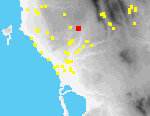 I21 Ambelofyto Lagou
I21 Ambelofyto Lagou
Site I21 is located on the relatively flat top of a ridge or spur, in a field planted with young olives, ca. 850 m. N of the village of Ambelofyto and ca. 50 m. E of the asphalt road that links Hora to Pyrgaki and Gargaliani. The ridge slopes most steeply to the SE and its N and S slopes are terraced.
The site of Lagou was first discovered by McDonald and Hope Simpson who found little there other than undecorated LH IIIB kylix stems in heaps of stones cleared from fields in the vicinity, and a skull in the scarp of the road near the site. MH pottery was also represented in their collections.
We managed to locate the site with difficulty in 1994, after having searched for it on several occasions since 1991. Little remains. In the field with the young olives is a large elongated pile of stones (ca. 30 m. L. x 4 m. max. W. x 1.5 m. H.) mixed with Mycenaean pottery, that has clearly been pushed to its present location by a bulldozer.[092.35] To its E, where young olives are themselves planted, the earth is slightly higher in elevation than in the surrounding field, and there are a few Mycenaean sherds.[092.36]
It seems likely that there had been, in the area of the young olives, a mound or mounds of earth that contained in situ cultural deposits, all now bulldozed into the rubble pile. This destruction seems to have occurred recently, since the pile of stone and pottery was relatively clear of grass and weeds in the summer of 1994 and the olive trees appeared to have been planted within the year.
A small group of pottery was collected, ranging in date from MH through LH IIIB. Especially interesting is a tin-coated kylix of LH IIIA1 (921000-1). Of the associated tracts, L94-170 produced good relevant material, L94-156 did not.